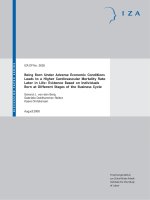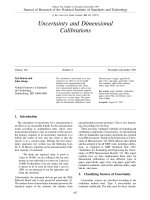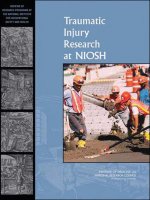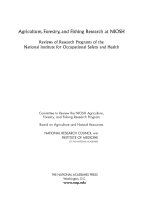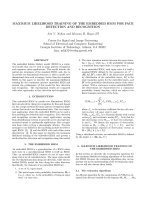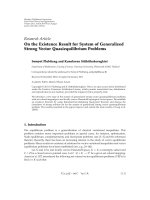Agriculture, Forestry, and Fishing Research at NIOSH Reviews of Research Programs of the National Institute for Occupational Safety and Health pptx
Bạn đang xem bản rút gọn của tài liệu. Xem và tải ngay bản đầy đủ của tài liệu tại đây (1.8 MB, 354 trang )
Copyright © National Academy of Sciences. All rights reserved.
Agriculture, Forestry, and Fishing Research at NIOSH
/>Committee to Review the NIOSH Agriculture,
Forestry, and Fishing Research Program
Board on Agriculture and Natural Resources
Agriculture, Forestry, and Fishing Research at NIOSH
Reviews of Research Programs of the
National Institute for Occupational Safety and Health
Copyright © National Academy of Sciences. All rights reserved.
Agriculture, Forestry, and Fishing Research at NIOSH
/>THE NATIONAL ACADEMIES PRESS • 500 Fifth Street, NW • Washington, DC 20001
NOTICE: The project that is the subject of this report was approved by the Governing Board of the
National Research Council, whose members are drawn from the councils of the National Academy
of Sciences, the National Academy of Engineering, and the Institute of Medicine. The members of
the committee responsible for the report were chosen for their special competences and with regard
for appropriate balance.
This study was requested by the National Institute for Occupational Safety and Health of the Centers
for Disease Control and Prevention and supported by Contracts 211-2006-19152 (Task Order 001)
and 200-2005-10881 (Task Order 0004). Any opinions, findings, and conclusions or recommenda-
tions contained in this document are those of the authors and do not necessarily reflect the views of
the organizations or agencies that provided support for the project. The content of this publication
does not necessarily reflect the views or policies of the Department of Health and Human Services,
nor does mention of trade names, commercial products, or organizations imply endorsement by the
U.S. Government.
International Standard Book Number-13: 978-0-309-11579-7
International Standard Book Number-10: 0-309-11579-5
Cover
: Photo credits: winter wheat harvest near Crary, North Dakota by Erin Wood; logging by
Professor Garland, Forest Engineer, Oregon State University; speedboat by Wojciech Kielpinski.
Additional copies of this report are available from the National Academies Press, 500 Fifth Street,
NW, Lockbox 285, Washington, DC 20055; (800) 624-6242 or (202) 334-3313 (in the Washington
metropolitan area); Internet, .
Copyright 2008 by the National Academy of Sciences. All rights reserved.
Printed in the United States of America
Suggested citation: National Research Council and Institute of Medicine. 2008. Agriculture, Forestry,
and Fishing Research at NIOSH. Committee to Review the NIOSH Agriculture, Forestry, and Fishing
Research Program. Rpt. No. 3, Reviews of Research Programs of the National Institute for Occupa-
tional Safety and Health. Washington, D.C.: The National Academies Press.
Copyright © National Academy of Sciences. All rights reserved.
Agriculture, Forestry, and Fishing Research at NIOSH
/>The National Academy of Sciences is a private, nonprofit, self-perpetuating society of distinguished
scholars engaged in scientific and engineering research, dedicated to the furtherance of science and
technology and to their use for the general welfare. Upon the authority of the charter granted to it
by the Congress in 1863, the Academy has a mandate that requires it to advise the federal govern-
ment on scientific and technical matters. Dr. Ralph J. Cicerone is president of the National Academy
of Sciences.
The National Academy of Engineering was established in 1964, under the charter of the National
Academy of Sciences, as a parallel organization of outstanding engineers. It is autonomous in its
administration and in the selection of its members, sharing with the National Academy of Sciences
the responsibility for advising the federal government. The National Academy of Engineering also
sponsors engineering programs aimed at meeting national needs, encourages education and research,
and recognizes the superior achievements of engineers. Dr. Charles M. Vest is president of the National
Academy of Engineering.
The Institute of Medicine was established in 1970 by the National Academy of Sciences to secure
the services of eminent members of appropriate professions in the examination of policy matters
pertaining to the health of the public. The Institute acts under the responsibility given to the National
Academy of Sciences by its congressional charter to be an adviser to the federal government and, upon
its own initiative, to identify issues of medical care, research, and education. Dr. Harvey V. Fineberg
is president of the Institute of Medicine.
The National Research Council was organized by the National Academy of Sciences in 1916 to as-
sociate the broad community of science and technology with the Academy’s purposes of furthering
knowledge and advising the federal government. Functioning in accordance with general policies
determined by the Academy, the Council has become the principal operating agency of both the
National Academy of Sciences and the National Academy of Engineering in providing services to the
government, the public, and the scientific and engineering communities. The Council is administered
jointly by both Academies and the Institute of Medicine. Dr. Ralph J. Cicerone and Dr. Charles M.
Vest are chair and vice chair, respectively, of the National Research Council.
www.national-academies.org
Copyright © National Academy of Sciences. All rights reserved.
Agriculture, Forestry, and Fishing Research at NIOSH
/>Copyright © National Academy of Sciences. All rights reserved.
Agriculture, Forestry, and Fishing Research at NIOSH
/>v
COMMITTEE TO REVIEW THE NIOSH AGRICULTURE,
FORESTRY, AND FISHING RESEARCH PROGRAM
PAUL D. GUNDERSON (Chair), National Farm Medicine Center (Emeritus),
Marshfield, Wisconsin
MARIA T. CORREA, North Carolina State University, Raleigh
R. ALAN DAVIS, American Seafoods Company, Seattle, Washington
JAMES A. DOSMAN, University of Saskatchewan, Saskatoon, Canada
WILLIAM A. GROVES, Pennsylvania State University, University Park
RONALD L. McALLISTER, CNH America LLC, New Holland, Pennsylvania
JAMES D. McGLOTHLIN, Purdue University, West Lafayette, Indiana
SUSAN H. POLLACK, University of Kentucky, Lexington
LORANN STALLONES, Colorado State University, Fort Collins
DON VILLAREJO, California Institute for Rural Studies (Emeritus), Davis
SUSANNA G. VON ESSEN, University of Nebraska Medical Center, Omaha
JAMES J. ZUICHES, North Carolina State University, Raleigh
Project Staff
PEGGY TSAI, Study Director
ROBIN SCHOEN, Director, Board on Agriculture and Natural Resources
JANET MULLIGAN, Research Associate
KAREN L. IMHOF, Administrative Assistant
NORMAN GROSSBLATT, Senior Editor
Copyright © National Academy of Sciences. All rights reserved.
Agriculture, Forestry, and Fishing Research at NIOSH
/>Copyright © National Academy of Sciences. All rights reserved.
Agriculture, Forestry, and Fishing Research at NIOSH
/>vii
Preface
“Cultivators of the earth are the most valuable citizens. They
are the most vigorous, the most independent, the most virtuous,
and they are tied to their country, and wedded to its liberty and
interests, by the most lasting bonds.”
—Thomas Jefferson
Jefferson’s perception has largely been replaced by other interpretations, but
the perception remains unchanged that the agriculture, forestry, and fishing (AFF)
workforce engages in noble activity that secures the nation’s present and future
fate. These populations deserve to work in environments that contribute to the
production of safe consumer products and that protect their health. The National
Institute for Occupational Safety and Health (NIOSH) is to be commended for its
keen desire to respond to decades of evidence suggesting that the AFF workforce
experiences some of the highest occupational disease and injury rates.
Congressional mandates regarding worker health and safety in agriculture,
forestry, and fishing date back only 2 decades for agriculture and just over 3 de-
cades for fishing. Yet, the interest of safety specialists, hygienists, engineers, public
health professionals, clinicians, and policymakers dates back to the 1940s, when
the war effort demanded an able, fit workforce to produce food and fiber for the
allied armed forces. Drawing on that long tradition, NIOSH forged an agricul-
tural occupational safety and health agenda in response to the 1990 congressional
mandate. Using public health approaches, the NIOSH Agriculture, Forestry, and
Copyright © National Academy of Sciences. All rights reserved.
Agriculture, Forestry, and Fishing Research at NIOSH
/>P r e f a c e
viii
Fishing Research Program (AFF Program) attempted to respond to worksites risks
and hazards numbering more than 3 million, a complex collage of child and adult
worker exposures, technological change unseen before in the history of human
labor in extractive industries, unprecedented public policy gyrations, and emerg-
ing genomic capability. En route, it conducted surveillance, deployed an innovative
regionalized system for the conduct of useful research and outreach activity, nour-
ished a generation of scientists and occupational health clinicians, and developed
useful linkages with organizations and entities that share a workforce safety and
health agenda. Now, under the guidance of the National Research Council and
the Institute of Medicine, it is time to pause, assemble results, analyze program
outcomes, and reflect for the future.
The committee’s composition was broad, reflecting both the diverse nature of
the three industry sectors covered by the NIOSH AFF Program and the diversity of
occupational exposures experienced by workers in the sectors (see Appendix D). Its
professional skill set spanned from agricultural engineering to agricultural exten-
sion and education, from clinical medicine to epidemiology, from anthropology
to physics, and from occupational hygiene to occupational safety. The committee
is due a full measure of gratitude for its selfless pursuit of its charge and its review
of published materials, other resources, and a large body of fugitive facts, publica-
tions, and other materials. It has been dogged in such activity, intent on securing
that which would enable it to discharge its mandate. To each member: a generous
measure of thanks is due for carrying this heavy load, all the while maintaining a
helpful demeanor and a charitable sense of humor and continuing to discharge
normal professional activity.
Not enough good can be said about staff assembled for this task by the Board
on Agriculture and Natural Resources. Always attentive, yet working under in-
tense time pressure, these professionals ably discharged both the exciting and the
mundane, responded to the committee’s numerous entreaties, patiently recruited
experts capable of assisting the committee, assembled background materials, and
maintained liaison with a large number of agencies and organizations. The com-
mittee would have been useless without their assistance, and to them an enormous
amount of gratitude is due.
This program evaluation has been difficult. The worksite complexity and
demographic makeup of the at-risk workforce is unprecedented, in terms of both
NIOSH program evaluation and worker health and safety programming across
North America. That NIOSH or other affected organizations or entities were not
always able to produce documentation is made all the more understandable once
the breadth of these combined sectors is grasped. Nevertheless, the committee
was not timid in formulating useful recommendations for program improvement
across future timeframes, and it believes that its present assessment reflects the best
Copyright © National Academy of Sciences. All rights reserved.
Agriculture, Forestry, and Fishing Research at NIOSH
/>P r e f a c e
ix
evidence marshaled to date of AFF worker outcomes in response to an occupational
safety and health program mandated by Congress.
The committee persevered in the belief that this nation’s AFF workforce de-
serves the best protection from risk that the nation can provide. Its work was
launched in the belief that that workforce is vitally important for the nation’s future.
To that workforce the committee dedicates its analyses reported herein.
Paul D. Gunderson
Committee Chair
Copyright © National Academy of Sciences. All rights reserved.
Agriculture, Forestry, and Fishing Research at NIOSH
/>Copyright © National Academy of Sciences. All rights reserved.
Agriculture, Forestry, and Fishing Research at NIOSH
/>xi
Acknowledgments
This report is a product of the cooperation and contributions of many people.
The committee would like to thank all the speakers who attended the first commit-
tee meeting on January 19, 2007, and the second committee meeting on March 28-
29, 2007, and others who provided information and input (see committee meeting
agendas in Appendix B).
The report has been reviewed in draft form by persons chosen for their diverse
perspectives and technical expertise in accordance with procedures approved by
the National Research Council’s Report Review Committee. The purpose of this
independent review is to provide candid and critical comments that will assist the
institution in making its published report as sound as possible and to ensure that
the report meets institutional standards of objectivity, evidence, and responsiveness
to the study charge. The review comments and draft manuscript remain confiden-
tial to protect the integrity of the deliberative process. We thank the following for
their review of this report:
John C. Bailar III, University of Chicago (Emeritus)
Dorianne Beyer, LMC Labor & Monitoring Consultants
Susan E. Cozzens, Georgia Institute of Technology
Vincent F. Garry, University of Minnesota (Emeritus)
James C. Helmkamp, West Virginia University
Anne Katten, California Rural Legal Assistance, Inc.
James A. Merchant, University of Iowa
Copyright © National Academy of Sciences. All rights reserved.
Agriculture, Forestry, and Fishing Research at NIOSH
/>xii
a c k n o w l e d g m e n t s
Barbara Neis, Memorial University, Canada
Robert (Chip) Petrea, University of Illinois at Urbana-Champaign
Sam Steel, Pennsylvania State University
John R. Wheat, University of Alabama School of Medicine
Although the reviewers listed above have provided constructive comments
and suggestions, they were not asked to endorse the conclusions or recommenda-
tions, nor did they see the final draft of the report before its release. The review of
this report was overseen by Dr. Frederick A. Murphy, University of Texas Medical
Branch at Galveston, and Dr. Harley W. Moon, Iowa State University (Emeritus).
Appointed by the National Research Council, they were responsible for making
certain that an independent examination of the report was carried out in accor-
dance with institutional procedures and that all review comments were carefully
considered. Responsibility for the final content of this report rests entirely with the
author committee and the institution.
Copyright © National Academy of Sciences. All rights reserved.
Agriculture, Forestry, and Fishing Research at NIOSH
/>xiii
Contents
SUMMARY 1
1 INTRODUCTION 15
Study Charge and Evaluation Committee, 15
Evaluation Approach, 16
The U.S. Agriculture, Forestry, and Fishing Industries, 20
Legislative History and Historical Perspective, 25
Organization of the Report, 31
2 THE IDEAL AGRICULTURE, FORESTRY, AND FISHING
RESEARCH PROGRAM 32
Overarching Program Characteristics, 32
Specific Program Components, 34
3 OVERALL PROGRAM ASSESSMENT 46
Agriculture, Forestry, and Fishing Research Program Goals, 47
4 REVIEW OF SURVEILLANCE RESEARCH 69
Strategic Goals and Objectives, 69
Logic Submodel, 70
Inputs, 70
Activities, 72
Copyright © National Academy of Sciences. All rights reserved.
Agriculture, Forestry, and Fishing Research at NIOSH
/>c o n t e n t s
xiv
Outputs, 75
Intermediate Outcomes, 77
End Outcomes, 77
Other Outcomes, 78
5 REVIEW OF RESEARCH ON HIGH-PRIORITY POPULATIONS
AT RISK 79
Strategic Goals and Objectives, 79
Logic Submodel, 81
Inputs, 81
Activities, 81
Outputs, 86
Intermediate Outcomes, 90
End Outcomes, 92
External Factors, 93
6 REVIEW OF HEALTH EFFECTS RESEARCH 94
Strategic Goals and Objectives, 94
Logic Submodel, 95
Inputs, 95
Activities, 97
Outputs, 102
Intermediate Outcomes, 108
End Outcomes, 109
7 REVIEW OF INTERVENTION RESEARCH 111
Strategic Goals and Objectives, 111
Logic Submodel, 112
Inputs, 112
Activities, 112
Outputs, 118
Intermediate Outcomes, 121
End Outcomes, 122
External Factors, 123
8 REVIEW OF OUTREACH ACTIVITIES: KNOWLEDGE
DIFFUSION AND TECHNOLOGY TRANSFER 124
Strategic Goals and Objectives, 124
Logic Submodel, 124
Inputs, 125
Copyright © National Academy of Sciences. All rights reserved.
Agriculture, Forestry, and Fishing Research at NIOSH
/>c o n t e n t s
xv
Activities, 128
Outputs, 128
Intermediate Outcomes, 129
End Outcomes, 131
Review of the NIOSH Centers for Agricultural Disease and Injury
Research, Education, and Prevention (Ag Centers), 132
Evaluation, 139
9 OTHER PROGRAMMATIC ELEMENTS IDENTIFIED BY
THE COMMITTEE 140
Stakeholders, 140
Health Services Research and Training, 147
Public Policy and Regulatory Advice, 153
Program Evaluation Initiatives, 155
10 PROGRAM SCORING AND RATIONALE 158
Assessment of Agriculture, Forestry, and Fishing Research Program
Relevance and Impact, 159
Discussion of Ratings for Relevance and Impact, 160
Additional Comments about Relevance, 167
Additional Comments about Impact, 169
Key Program Limitations, 171
Conclusion, 174
11 NEW AND EMERGING RESEARCH IN AGRICULTURAL,
FORESTRY, AND FISHING SAFETY AND HEALTH 175
Identification of New and Emerging Research by the National
Institute for Occupational Safety and Health, 175
New Research Identified by the Committee, 178
Emerging Research and Issues Identified by the Committee, 183
Conclusion, 194
12 RECOMMENDATIONS FOR PROGRAM IMPROVEMENT 195
Recommendations, 196
Summary, 210
GLOSSARY 211
REFERENCES 214
Copyright © National Academy of Sciences. All rights reserved.
Agriculture, Forestry, and Fishing Research at NIOSH
/>c o n t e n t s
xvi
APPENDIXES
A Framework for the Review of Research Programs of the National
Institute for Occupational Safety and Health 231
B Committee Methods for Gathering Information 275
C Information Provided by the NIOSH AFF Program 288
D Biographic Sketches of Committee Members 294
E Methods for Identifying the Agriculture, Forestry, and Fishing
Workforce Population 301
F Policies and Regulations Affecting the Agriculture, Forestry, and
Fishing Workforce 317
G Board on Agriculture and Natural Resources 326
Copyright © National Academy of Sciences. All rights reserved.
Agriculture, Forestry, and Fishing Research at NIOSH
/>xvii
Tables, Figures, and Boxes
TABLES
1-1 Size of Agriculture, Forestry, and Fishing Workforce Populations, 22
3-1 Conferences, Symposia, and Working Meetings to Engage Stakeholders, 58
4-1 NIOSH Programs with Surveillance Activities, 73
6-1 Research Emphases of Some NIOSH Ag Centers, 101
7-1 Programs with Intervention Research Activities, 114
7-2 Federal Agencies Partnering with the NIOSH AFF Program on
High-Priority Populations at Risk, 117
E-1 Directly Hired Farm Workers and Agricultural Service Workers in the
United States, 2006, 305
E-2 Classes of Workers: Civilian Population 16 Years Old and Older Employed
in Agriculture, Forestry, Fishing, and Hunting (AFFH), 307
E-3 Census Special Equal Employment Opportunity (EEO) Tabulations,
United States, 1990 and 2000, 308
Copyright © National Academy of Sciences. All rights reserved.
Agriculture, Forestry, and Fishing Research at NIOSH
/>xviii
t a b l e s , f i g u r e s , a n d b o x e s
E-4 Hired Farmworker Employment, 1998-2006, Annual Average Economic
Research Service (ERS) Analysis of Current Population Survey (CPS) (at
least 15 years old) versus Farm Labor Survey (all ages), 310
E-5 Hired Farmworker Employment, Farm Labor Contractors, California,
2000: Comparison of Farm Labor Survey, Agricultural Bulletin Surveys,
and ES202 Reports, 315
E-6 Paid Claims Under Workers’ Compensation Insurance, Hired Farm
Workers, California, 1990-1999, Claim Frequency Report (Level 5), 316
FIGURES
1-1 The AFF Program logic model, 18
2-1 The intervention research framework and phases, 41
4-1 Surveillance logic submodel, 71
5-1 Priority populations at risk research logic submodel, 82
6-1 Health effects research logic submodel, 96
7-1 Intervention research logic submodel, 113
8-1 Knowledge diffusion and technology transfer logic submodel, 126
8-2 The PNASH Center partnership model, 127
BOXES
1-1 Statement of Task, 17
3-1 Major Goals of the AFF Program, 47
3-2 Logic Model Terms and Examples, 49
3-3 NIOSH Centers for Agricultural Disease and Injury Research, Education,
and Prevention (Ag Centers), 55
3-4 External Factors That Affect the AFF Program (as identified by NIOSH), 67
8-1 Research to Practice (r2p), 130
10-1 Scale for Rating Program Relevance, 159
10-2 Scale for Rating Program Impact, 161
Copyright © National Academy of Sciences. All rights reserved.
Agriculture, Forestry, and Fishing Research at NIOSH
/>xix
t a b l e s , f i g u r e s , a n d b o x e s
10-3 An Exemplary AFF Program: Commercial Fishing Injuries and Fatalities,
NIOSH Alaska Field Station, 162
B-1 Letter Inviting Comment on the NIOSH Agriculture, Forestry, and
Fishing Research Program, 277
B-2 Emerging Research Areas in Agriculture, Forestry, and Fishing Safety and
Health Suggested by Stakeholders, 280
Copyright © National Academy of Sciences. All rights reserved.
Agriculture, Forestry, and Fishing Research at NIOSH
/>Copyright © National Academy of Sciences. All rights reserved.
Agriculture, Forestry, and Fishing Research at NIOSH
/>xxi
Abbreviations and Acronyms
ACS American Community Survey
AFF agriculture, forestry, and fishing
AFS Alaska Field Station
AgDARE Agricultural Disability Awareness and Risk Education
AMSEA Alaska Marine Safety Education Association
AOISS Alaska Occupational Injury Surveillance System
APMP Agricultural Personnel Management Program
ARC agricultural research center
ASABE American Society of Agricultural and Biological Engineers
ASAE American Society of Agricultural Engineers
ASH-NET Agriculture Safety and Health Network
ASPH Association of Schools of Public Health
ATR Alaska Trauma Registry
ATV all-terrain vehicle
BLS Bureau of Labor Statistics
CA EDD California Employment Development Department
CAFO concentrated animal feeding operation
CAIS Child Agricultural Injury Survey
CalOSHA California Occupational Safety and Health Administration
CARE Children’s Act for Responsible Employment
Copyright © National Academy of Sciences. All rights reserved.
Agriculture, Forestry, and Fishing Research at NIOSH
/>xxii
a b b r e v i a t i o n s a n d a c r o n y m s
CDC Centers for Disease Control and Prevention
CDPHE Colorado Department of Public Health and Environment
CES Cooperative Extension Service
CEW Census of Employment and Wages
CFIVSA Commercial Fishing Industry Vessel Safety Act
ChE cholinesterase
CIRS California Institute for Rural Studies
CoA Census of Agriculture
CPS Current Population Survey
CPSC Consumer Product Safety Commission
CROPS cost-effective rollover protective structure
CSF Certified Safe Farm
DART Division of Applied Research and Technology
DHHS Department of Health and Human Services
DOL Department of Labor
DRDS Division of Respiratory Disease Studies
DSHEFS Division of Surveillance, Hazard Evaluations, and Field Studies
DSR Division of Safety Research
EEO Equal Employment Opportunity
EID Education and Information Division
EPA U.S. Environmental Protection Agency
ERC Education and Research Center
ERS Economic Research Service
ESA Employment Standards Administration
FACE Fatality Assessment and Control Evaluation
FFA Future Farmers of America
FFHHS Farm Family Health and Hazard Surveillance
FISH Fishing Industry Safety and Health
FLSA Fair Labor Standards Act
FOPS falling object protective structure
FTE full-time equivalent
FY fiscal year
GAO Government Accountability Office
GLCASH Great Lakes Center for Agricultural Safety and Health
GM genetically modified
GMO genetically modified organism
Copyright © National Academy of Sciences. All rights reserved.
Agriculture, Forestry, and Fishing Research at NIOSH
/>xxiii
a b b r e v i a t i o n s a n d a c r o n y m s
GPCAH Great Plains Center for Agricultural Health
HAVS hand-arm vibration syndrome
HELD Health Effects Laboratory Division
HHE Health Hazard Evaluation
HICAHS High Plains Intermountan Center for Agricultural Health and
Safety
HO hazardous orders
HRSA Health Resources and Services Administration
IFISH International Fishing Industry Safety and Health
IFQ individual fishing quotas
ILO International Labour Organization
IOM Institute of Medicine
IPM integrated pest management
IRCA Immigration Reform and Control Act
MAF Master Address File
MMWR Morbidity and Mortality Weekly Report
MSAWPA Migrant and Seasonal Agricultural Worker Protection Act
MSD musculoskeletal disorder
MSHA Mine Safety and Health Administration
NAGCAT North American Guidelines for Children’s Agricultural Tasks
NAICS North American Industry Classification System
NASC NIOSH Agricultural Steering Committee
NASD National Agriculture Safety Database
NASS National Agricultural Statistics Service
NAWS National Agricultural Workers Survey
NCASH National Coalition for Agricultural Safety and Health
NCCRAHS National Children’s Center for Rural and Agricultural Health and
Safety
NCHS National Center for Health Statistics
NCI National Cancer Institute
NEC Northeast Center for Agricultural and Occupational Health
NEISS National Electronic Injury Surveillance System
NFMC National Farm Medicine Center
NGO non-governmental organization
NHTSA National Highway Traffic Safety Administration
NIEHS National Institute of Environmental Health Sciences
Copyright © National Academy of Sciences. All rights reserved.
Agriculture, Forestry, and Fishing Research at NIOSH
/>xxiv
a b b r e v i a t i o n s a n d a c r o n y m s
NIFS National Institute for Farm Safety
NIH National Institutes of Health
NIOSH National Institute for Occupational Safety and Health
NORA National Occupational Research Agenda
NPFVOA North Pacific Fishing Vessel Owners’ Association
NPPTL National Personal Protective Technology Laboratory
NLRA National Labor Relations Act
NSC National Safety Council
NTOF National Traumatic Occupational Fatality
NYCAMH New York Center for Agricultural Medicine and Health
OEP Office of Extramural Programs
OHNAC Occupational Health Nurses in Agricultural Communities
OMB Office of Management and Budget
OSHA Occupational Safety and Health Administration
PNASHC Pacific Northwest Agricultural Safety and Health Center
PRL Pittsburgh Research Laboratory
QALS Quarterly Agricultural Labor Survey
r2p research to practice
RAW replenishment agricultural worker
RFA request for application
RFP request for proposal
ROPS rollover protective structure
RR relative risk
SAW seasonal agricultural worker
SENSOR Sentinel Event Notification of Occupational Risk
SMV slow-moving vehicle
SOII Survey of Occupational Injuries and Illnesses
SRL Spokane Research Laboratory
SW Center Southwest Center for Agricultural Health, Injury Prevention, and
Education
TRAC-Safe Tractor Risk Abatement and Control
UI unemployment insurance
USCG U.S. Coast Guard
Copyright © National Academy of Sciences. All rights reserved.
Agriculture, Forestry, and Fishing Research at NIOSH
/>xxv
a b b r e v i a t i o n s a n d a c r o n y m s
USDA U.S. Department of Agriculture
UTHCT University of Texas Health Center at Tyler
WCAHS Western Center for Agricultural Health and Safety
WCIRB Workers’ Compensation Insurance Rating Bureau
WHO World Health Organization
WoRLD Work-Related Lung Disease Surveillance Report


